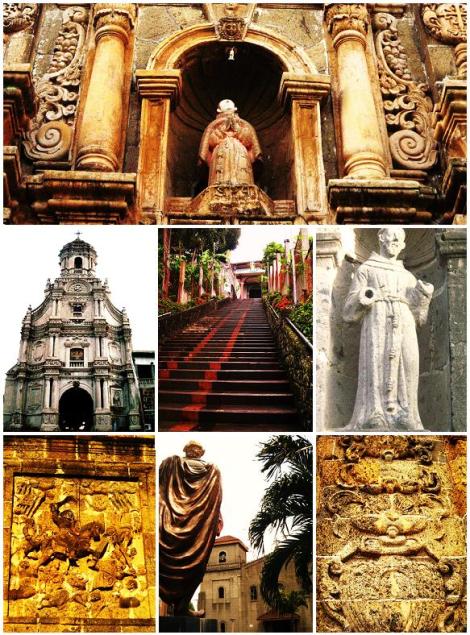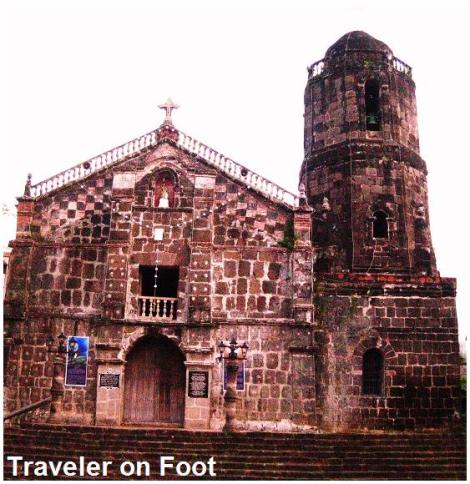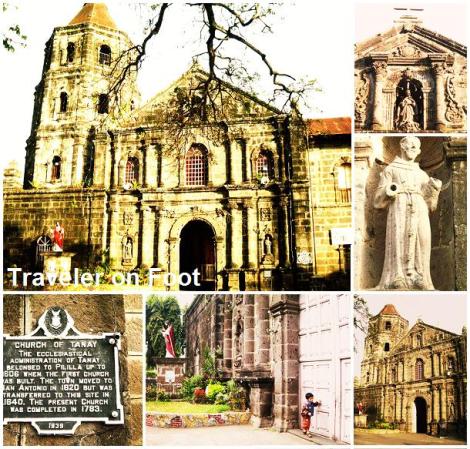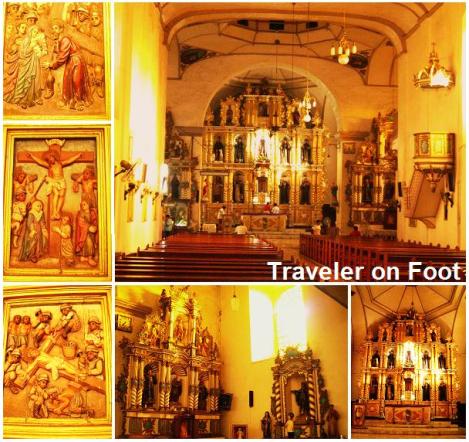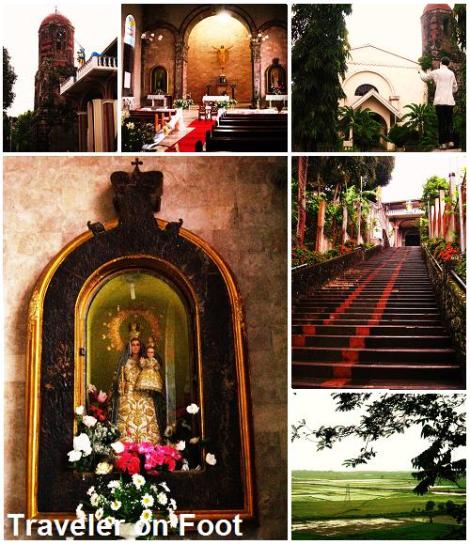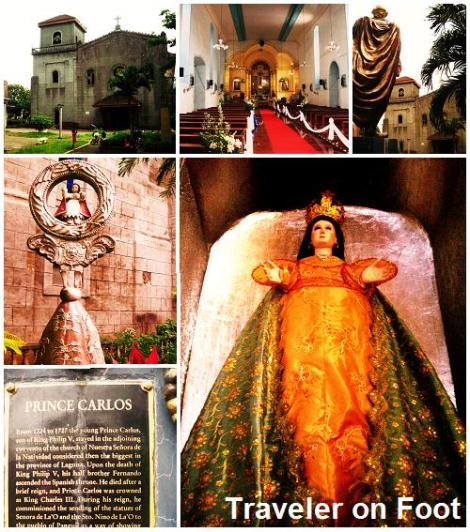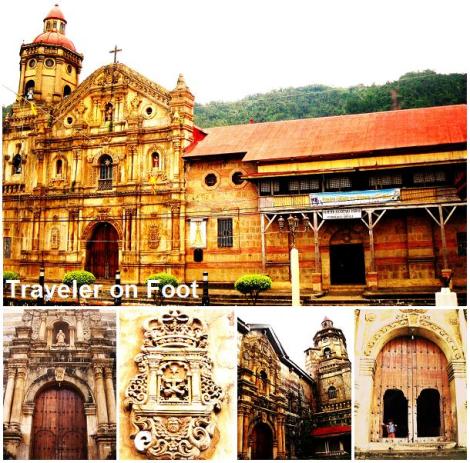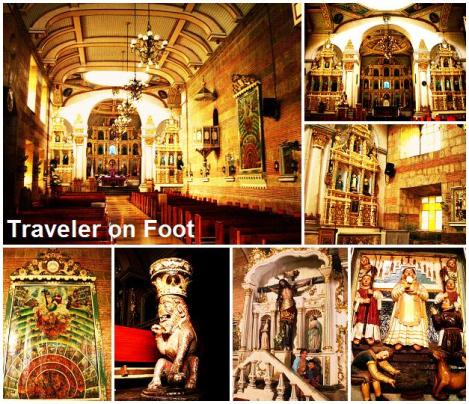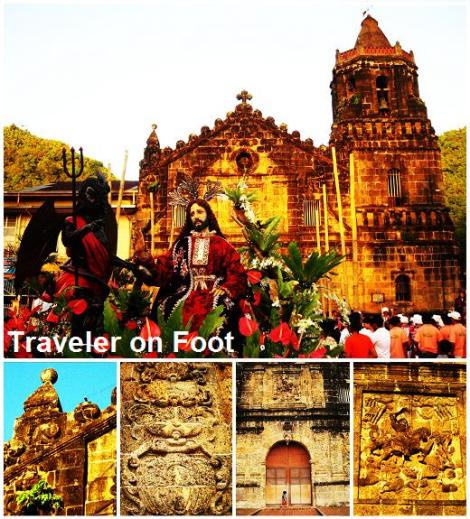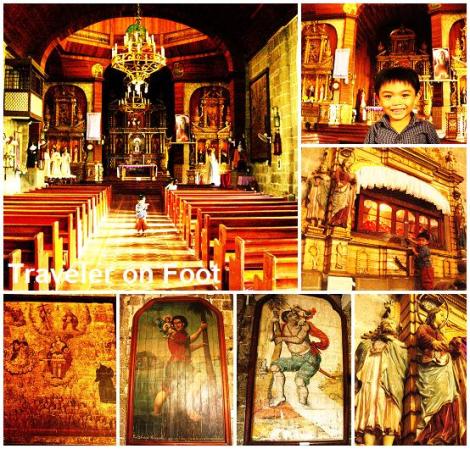
We will never get tired visiting the province of Laguna. It’s not enough that we were there countless of times for a variety of reasons, mostly driven by our curiosity on what is there to learn and to experience. One of the things that is attracting us back for those spontaneous and unplanned trips to this province is the journey going there via a winding path carved out from the slopes of the Sierra Madre.

In our regular days, we waste at least two hours in traffic going to work in Makati or to the malls in Ortigas. As compared when going to Laguna, we experience the same amount of travel time via the Manila East Road while enjoying the sights on both sides of the road with scenery enhanced by the dense forest and by the Laguna de Bay. Seventeen of Laguna’s town and a city sit along the shore of Laguna de Bay -the largest lake in country and from which the province received its name.
A huge balete tree on the side of the mountain road, said to be inhabited by a community of elves and fairies, marks the boundary between Laguna and the province of Rizal. Mabitac is the first town when coming from the Manila East Road. But from South Luzon Expressway, Mabitac is on the northern most edge of Laguna.

We first came to Mabitac to visit its church with 126 steps. To reach the church from the road, we huffed and puffed our way up the wide staircase that is integral to all of the town’s religious rites. The townsfolk believe that scaling the 126 steps entitles them to receive more blessings from their patroness -the Nuestra Señora de Candelaria. Which is why the bride and groom with their entire entourage would climb up the enormous staircase to the altar. The departed on the other hand would be carried for the requiem mass in the church and down again for a procession to the cemetery.
Jeepneys coming from the terminal in Tanay Rizal passed by Mabitac to unload passengers in the next town –Siniloan. From the jeepney terminal in Siniloan, travelers can take rides that would bring them to either Real in Quezon or to the rest of the lakeshore town up to the provincial capital in Sta. Cruz.
How the town of Siniloan received its name is interesting. According to folklore, the town got its name when the three brothers Juan Puno, Juan Pili, and Juan Puhawan equally divided the town among themselves, hence sinluluang or same width.

From Siniloan, we passed through a road in the middle of a rice field to reach the next town. The Town of Pangil is devoted to Mary as the Virgen de la O, the Virgin pregnant with Child Jesus who is called Sto. Niño de la O. The statues of both Mother and Child are Gifts from Prince Carlos III of Spain (who later inherited the Kingdoms of Sicily and Naples as Charles VII) whose statue stands in front of the 17th century stone church. While the image of the pregnant Virgin is enshrined in the left side altar, the image of the Child Jesus is kept somewhere else.

In one of my visits in Pangil, I’ve searched for the keeper of the original Sto. Niño de la O. I’ve learned that the image is only brought out to the church during the nine-day novena commemorating the third month of the Blessed Mother’s pregnancy (usually coincides with the days of the Simbang Gabi). Following the novena mass is the rite led by the children devotees. A child is assigned to bear the Sto. Niño de la O that is mounted in a silver halo resting on a skirted rod. The child devotee waltzed it up and down the church aisle while the rest of the children sing the Dic Mihi, a Latin song in honor of the Child Jesus.

While the children of Pangil sings the Dic Mihi to the beat of the drums, the next lakeshore town dances to the beat of the Turumba. The town of Pakil is famous for the longest fiesta in the Philippines. The Turumba Festival is held seven times a year in honor of the Virgin of Sorrows. It begins from the Friday before Holy Week up to seventh Sunday after Easter and during the town fiesta on May 12 and the feast day of Virgin of Sorrow on September 15.

The Original Image of the Virgin of Sorrows is a 9×11 painting framed in hammered silver. It is said to have been caught by a group of fishermen while it strangely stays afloat on the bay. The miraculous painting is kept in a prayer room in Pakil Church. Too small to be taken out to procession, it had been replaced by a statue from Spain. During the 2008 September fiesta, we were part of the crowd who jiggled to the beat of the lively Turumba sa Birhen song.


In our regular visits to Laguna, we habitually make a stop-over in Pakil to recite the rosary in its 17th century church. Every part of the San Pedro de Alcantara Church is a tasteful piece of folk religious art, from the mural of heaven, purgatory and hell by Jose Dans to the exquisitely carved retablo and the church’s heavily decorated façade, to the holy water font resting on the devil’s head.

It is not surprising that Pakil is home to famous names in Philippine art like Jovan Benito, Alan Rapsing, Bernard Vista, and Danny Dalena. While Danny Dalena House-Museum was converted into a repository of Pakil’s religious heritage as showcased in the artist’s paintings and collection, Vista founded an Cafe and Art Space to showcase Pakil’s Crafts such as whittling softwood into filigreed fans, peacocks, butterflies, birds and flowers.

If Pakil is overwhelming enough with crafts and folk art, the next town is overloaded with fine art. I cannot agree more with artist and UPLB professor Glenn Cagandahan who said that Paete is the Fine Arts Capital of the Philippines. At Kape Kesada, art gallery owner Nilo Valdecantos introduced us to the paintings and sculptures of the Paete Artists Guild.


It is in this town where we trained our eyes to appreciate the artworks of Manny Baldemor, Dominic Rubio, Joseph Bañes, Beyok Acala, Odette Cagandahan, Glenn Cagandahan, Ben Dailo, Angelo Baldemor, and Luis Ac-ac. And as tangible reminders of our several trips to this town, we have their artworks displayed in our home together with exquisite Paete Woodcarvings.

Everything about Paete has something to do with the chisel, from the legend how the town received its name to its church with its Baroque façade and retablo to the superbly carved religious images paraded during Holy Wednesday Procession -all showcase the Art Heritage of Paete.

If travelers left early in morning and followed the itinerary stated above, they should be finished exploring Mabitac, Pangil, Pakil, and Paete and ready to proceed to the next town for lunch. The town of Kalayaan has a popular restaurant serving traditional and exotic dishes. Exotik Restaurant is nestled on the hillside along the national highway in Longos, Kalayaan.

Exotik’s menu ranges from the traditional Filipino food like nilagang baka (beef soup), inihaw na baboy (pork barbeque), sinigang (pork in tamarind soup), to the inadobong or giunataang palaka (frog), bayawak (minotor lizard), and sawa (python). There is a gift shop and a small zoo to explore while waiting for these traditional and exotic delicacies to be served. The last time we had our lunch at Exotik, we were timid to try out their exotic dishes so we ended up having inihaw na baboy and nilagang baka for lunch.

We thought that an afternoon walking tour is ideal after a heavy lunch and where else to do it but in the streets of Lumban. A few minutes away from Kalayaan is the town center of Lumban. While Paete is known for its woodcarving and Pakil for it whittling craft, Lumban is known for its embroidery.


In our recent visit to this lakeshore town, we saw several large rectangular bamboo frames called bastidor, upon which gossamer cloth is stretched out to dry under the afternoon sun. They are like billboards along EDSA, but this billboards tells us we are in the Embroidery Town of Lumban.
Inside houses are embroidery workshops where both men and women used a tambor, a round wooden stretcher where the cloth is stretched out while patterns for the barong tagalog, ternos, gowns, and tablecloths are being stitched.


In that same afternoon, we went to the next town to continue our sightseeing. Pagsanjan had everything to qualify as a key tourist destination. This town has the famous waterfalls and gorge and a number of grand ancestral houses lining its main road. For those who are still gathering enough guts to try out the river ride to the waterfalls, a walking tour along its Calle Rizal should be enjoyable enough for curious travelers like us.

From the 1690 Pagsanjan Church, we walked along the short stretch of Calle Rizal to gasped in awe at the stately houses until we reached Puerta Real -beneath those town lions that stand on this stone gate. This stone gate was built to recall the legendary miracle attributed to the town’s patroness, the Nuestra Señora de Guadalupe.
According to the legend, a group of bandits led by Tangkad came to bring havoc to the town on December 8, 1877. It is said the they stopped at the site of the stone gate upon seeing a luminous apparition of a beautiful lady holding a shining sword.

From Pagsanjan, we passed by the provincial capital of Sta. Cruz on the way to our last stop for the day-Pila. This Laguna town has a distinct 20th century feeling. Surrounding its town square are grand ancestral houses all dating back to the 1920s. Quite recent compared to the town’s centuries of history.

Pila was already a thriving trading town even before the arrival of the Spaniards. Impressed by its extensive territory and the nobility of its people, the Spanish conquistadores conferred on the town with a special title in 1610 as La Noble Villa de Pila.
During the Spanish times, only a handful of cities and towns were granted the title of Villa. Among them were La Villa Santisimo Nombre Jesus de Cebu in 1565; La Villa de Santiago de Libon Albay in 1573; La Villa Fernandina de Vigan in 1574; La Villa Rica de Arevallo in Iloilo (1581); La Muy Noble Villa de Tayabas in 1703; La Villa de Bacolor in 1765; and La Villa de Lipa in 1887. These towns were considered as privileged subjects of the Spanish Crown. They were exempted from polo y servicio or force labor.

Touring from Mabitac to Pila should be enough to complete the day tour of Laguna via its back door, the Manila East Road. While the sun sets, one can travel towards the rest of the lakeshore towns passing Victoria, Calauan, Bay all the way to Metro Manila via the South Luzon Expressway. But for those who want to explore more of Laguna, we have a day two itinerary. This time a whole day adventure around Laguna towns located high up in the foothills of mystical Mount Banahaw.

Day two of Laguna tour begins waiting forever for a jeepney ride at the junction of the national highway near the boundary of Pagsanjan and Sta. Cruz. The road to our first stop was long and slow. Our boredom gradually faded away when we drove by Sta. Maria Magdalena Church. This enormous 1829 church looked familiar since its baroque facade has been used as background in several movies and television commercials.

In one of our travels in this part of the province, we went inside the church’s convent to see a relic of an earlier freedom fighter. When General Emilio Jacinto suffered a combat wound in the thigh during an encounter with the Spanish forces at Maimpis River in 1898, he was dragged by the calzadores from the battle site and dumped him in Magdalena Church.
Unattended, he lay bleeding on a the brick stairway until he was brought to Sta. Cruz to be stitched up by a Spanish surgeon. A portion of the stairway leading to the convent is still stained with Jacinto’s blood. This section is encased in glass and protected by grillwork as a memorial to the Brain of the Katipunan.


Less than an hour from Magdalena is the town known for its footwear, lambanog, uraro, and its centuries-old church. The footwear making industry in the town of Liliw started in 1931 when Casiano Pisueña fashioned the first pair of slippers made from coconut fiber and rubber as an alternative to the heavy wooden clogs and close shoes. A vibrant industry of footwear making followed. Along the town’s main street are stores and workshops selling slippers and different kinds of footwear.

Tour visits in Liliw include trips to footwear stores and workshops, lambanog distilleries, uraro bakeshops, and its church. Liliw’s Lambanog is said to be the best in the country and is sold in 80, 84, and 94 proof. Uraro or biscuits made from arrowroot flour embossed with floral designs is a specialty of Liliw. St. John the Baptist Church is known for its elegant bricked facade and imposing belfry.

The next town is Nagcarlan. The first time we went this town, we visited its famous landmark -the underground cemetery. Standing on a mound, the cemetery was constructed in 1851 by Fray Vicente Velloc to accommodate a couple hundred niches, more than a hundred graveyard within the cemetery’s octagonal grounds, and some 36 more niches in the crypt below the chapel. In time, it quickly filled its capacity and later neglected until in 1981 when the National Historical Institute restored it for it was in the crypt where Pedro Paterno and Revolutionary General Severino Taino laid the plans for the Truce of Biak-na-Bato.
A few walks from the arched doorway of the cemetery’s perimeter wall is the statue of the Ana Kalang -founder of Nagcarlan. According to the legend Ana Kalang was a wealthy woman who never turned away anyone in need. When the first Catholic Church was being built, she generously donated money required in the construction.
Nagcarlan Church was built in 1752. Although its has been extensively modernized, some of the baroque architecture accomplished by Father Velloc is still visible, particularly on the tiered façade of the massive church. Old folks claimed that a tunnel that connects the church to the underground cemetery was built to serve as an escape route for the friars.

If Nagcarlan is filled with folk mysteries, the next town is mystical. The town of Majayjay humorously named because it has been told that in the olden days going up to this Laguna town is arduous and by the time ancient travelers reached the town center, they are already gasping their breath in exhaustion as in hay…hay… a town with many “hays” or Majayjay. There must be something in Majayjay that’s worth seeing that even Governor William Howard Taft (later US President) built a road to make the ascent to the town less strenuous.

Majayjay Church was built between 1711 to 1730. It has been described to be unusually tall for Philippine churches. Its walls are three layers thick as a result of sandwiching the original walls with bricks on both sides. But this enormous church was built out of slave labor. 4,000 of its villagers were coerced to put up the church together block by block. Those who defied friar orders were either lashed or persecuted. This acts spawned resentment resulting to the division of Majayjay into three towns (the two were Luisiana and Magadalena).
Another handiwork of forced labor is the Puente de Capricho or Bridge of Whims, an unfinished bridge jutting out from the Olla River. Like its church, many of its townspeople suffered for a priest’s ambition. Building duties were compulsory and those who refused were whipped, which explains why the locals called this unfinished bridge as Tulay Pigue or Buttock Bridge.

Twenty minutes from the town center is Taytay Falls. The hike to the falls is through the shoulders of an irrigation canal. Although a cemented walkway was built recently to make the decent easy for tourists, the surrounding ancient trees with their enormous leaves form a canopy that make the hike down to the three-tiered falls worth the trip.


Touring the Laguna towns of Magdalena, Liliw, Nagcarlan, and Majayjay takes an entire day because of the long wait it took for us to ride a jeep that would take us from one town to the next. But the slow and long pace is worth it. In one of our trips to Majayjay, we went for an hour ride on misty mountain road going to Lucban for the Pahiyas Festival. But to continue the grand tour of Laguna, we suggest going back to Nagcarlan and taking a ride going to San Pablo City to spend a Restful Evening at Casa San Pablo.

San Pablo City offers a lot for those who are willing to spend day three in Laguna. The first to be declared as a city in the entire province, San Pablo is known for its seven lakes, most famous of which is Sampaloc Lake. And like all places in Laguna, it has a legend. According to the story, a stingy couple who owned a vast sampaloc orchard drove away an old woman beggar. A night of heavy rain followed that submerged the entire orchard which became today’s Sampaloc Lake.

But geologists explained that Sampaloc Lake and the lakes of Palapakin, Muhikap, Kalibato, Yambo, and Pandin were crater lakes formed by earthquakes caused by volcanic activity. In one of our trips in San Pablo City, we hired a bamboo raft that ferried us across the Pandin Lake. A tour of Sampaloc and Pandin lakes is included in the Viaje del Sol itinerary as well as Kusina Salud, where we had lunch after spending a morning tour at San Pablo Church, Fule-Malvar Mansion and lakes of Sampaloc and Pandin.
From San Pablo, we took a bus that drove by the towns of Alaminos and Sto. Tomas, Batangas until we saw the most visible landmark of our next stop. Mount Makiling is a dormant volcano that dominates the skyline of Los Baños and home to the mountain nymph Mariang Makiling.

The Legend of Mariang Makiling is a story about a beautiful fairy protecting the mountain. Old folks claim that they have felt her presence in the mountain. She was seen dressed in white while bathing in one of the several springs in the mountain.

The town of Los Baños was called Mainit, referring to the numerous hot springs in the area. Because of its mountain climate and therapeutic properties of its water, the Spaniards built vacation houses, one of which is a palatial villa for the Governor-General mentioned in Jose Rizal’s El Filibusterismo. Along its main road hawkers and fancy billboard invite tourists to booked in the several resorts harnessing Los Baños’s hot springs.
In one of our trips to Los Baños, we went around the University of the Philippines (UPLB) and drove further up the mountain to see the National Arts Center. Like in UP Diliman, a jeepney ride that goes around the campus is available.

Los Baños is where Paciano Rizal, brother of our national hero spent his years in retirement. In 1927, an American style bungalow was built by architect Andres Luna de San Pedro, son of master painter Juan Luna. The Paciano House is a heritage shrine and a living museum.


If the people of Los Baños takes pride for their town’s association with Paciano Rizal, the neighboring town of Calamba is a territory of the national hero Jose Rizal. Calamba is the hometown of the Mercado Family. It was in this town where Don Francisco Mercado and Doña Teodora Alonso built a house along Calle Real next to the Calamba Church. It was in this home where the Mercado children, all eleven of them were raised, including our national hero Jose Rizal.

In 1891, Spanish authorities confiscated the Mercado House and the family members were driven out with all their belongings. Paciano managed to occupy the house during the revolution, but it eventually sold and in time fell to neglect then demolished.
In 1949, with the bulk of the funding coming from school children, architect Juan Nakpil led the excavation of the house’s foundation and using gathered data, reconstructed a replica of our national hero‘s ancestral house. The Jose Rizal Shrine in Calamba is the most visited national landmark in Laguna.
Day three of the Grand Laguna Tour ends in Calamba. We feel that Laguna towns after Calamba has become urbanized, owing it to the real estate developers who advertise “a few minutes away from Makati…” For some, the toll booth in Calamba is the end of South Luzon Expressway, but for us it is the gateway to what is still provincial Laguna -rustic, rural, and romantic. –TOF





















